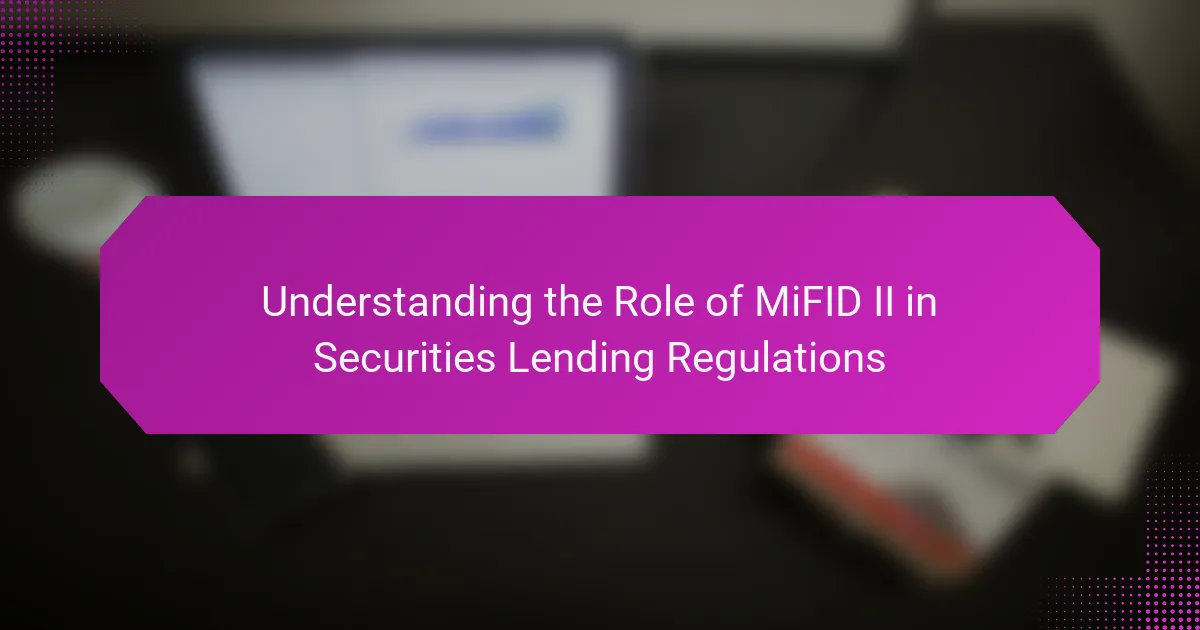
What is MiFID II and its significance in Securities Lending Regulations?
MiFID II, or the Markets in Financial Instruments Directive II, is a comprehensive regulatory framework implemented in the European Union. It aims to enhance transparency and investor protection in financial markets. MiFID II significantly impacts securities lending regulations by establishing stricter rules for trading and reporting. It mandates that all securities lending transactions be reported to a trade repository. This requirement improves market transparency and helps regulators monitor systemic risks. Additionally, MiFID II enforces best execution standards, ensuring that clients receive optimal terms in securities lending. This regulatory framework ultimately promotes fair competition and protects investors in the securities lending market.
How does MiFID II impact the securities lending landscape?
MiFID II significantly impacts the securities lending landscape by enhancing transparency and regulatory oversight. It mandates detailed reporting requirements for securities lending transactions. This includes the obligation to disclose lending fees and collateral details. MiFID II also affects the treatment of client assets, requiring stricter segregation and protection measures. These changes aim to reduce systemic risk and improve market integrity. Additionally, the regulation encourages more standardized practices across the industry. As a result, market participants must adapt their operations to comply with the new rules. This shift can lead to increased operational costs for firms involved in securities lending. Overall, MiFID II reshapes the landscape by promoting transparency and regulatory compliance.
What are the key principles of MiFID II related to securities lending?
The key principles of MiFID II related to securities lending include transparency, investor protection, and enhanced reporting requirements. Transparency mandates that firms disclose all costs and charges associated with securities lending transactions. Investor protection ensures that clients’ interests are prioritized, requiring firms to act honestly and fairly. Enhanced reporting requirements necessitate detailed reporting of securities lending activities to regulatory authorities. These principles aim to create a more robust regulatory framework and improve market integrity.
How does MiFID II enhance transparency in securities lending transactions?
MiFID II enhances transparency in securities lending transactions by imposing stringent reporting requirements. It mandates that all securities lending transactions be reported to a trade repository. This allows regulators and market participants to access real-time data on lending activities. The directive also requires firms to disclose the terms and conditions of securities lending agreements. This includes fees, collateral arrangements, and the identity of the parties involved. Such disclosures help mitigate information asymmetry in the market. By increasing the availability of data, MiFID II promotes better risk assessment and management. Overall, these measures foster a more transparent and efficient securities lending market.
What are the compliance requirements under MiFID II for securities lending?
MiFID II compliance requirements for securities lending include transparency, reporting, and investor protection. Firms must provide detailed information on securities lending transactions. This includes disclosing the risks and costs associated with lending activities. Additionally, firms are required to report transactions to a trade repository. They must ensure that clients understand the implications of securities lending. This involves obtaining informed consent from clients before proceeding. Furthermore, firms must maintain records of all securities lending transactions for regulatory review. Compliance with these requirements aims to enhance market integrity and protect investors.
What specific obligations do firms have under MiFID II?
Firms have specific obligations under MiFID II that ensure transparency and investor protection. These obligations include conducting suitability assessments for clients before recommending financial products. Firms must also provide clear and comprehensive information about services and costs. They are required to maintain records of all client communications and transactions. Additionally, firms must implement robust systems for managing conflicts of interest. They must ensure best execution for client orders, prioritizing the best possible outcome. MiFID II mandates firms to adhere to strict reporting requirements for trades and transactions. Compliance with these obligations is monitored by national regulators to protect investors and maintain market integrity.
How do firms ensure compliance with MiFID II in securities lending practices?
Firms ensure compliance with MiFID II in securities lending practices by implementing robust governance frameworks. They establish clear policies and procedures that align with regulatory requirements. Regular training for staff on MiFID II obligations is essential. Firms also conduct thorough risk assessments to identify potential compliance gaps. Additionally, they maintain accurate records of securities lending transactions. Regular audits and compliance checks help monitor adherence to MiFID II standards. Engaging with legal and compliance experts further strengthens their compliance efforts. These measures collectively ensure that firms operate within the regulatory framework set by MiFID II.

How does MiFID II interact with other regulations in securities lending?
MiFID II interacts with other regulations in securities lending by establishing a comprehensive framework for transparency and investor protection. It aligns with regulations such as the Securities Financing Transactions Regulation (SFTR) and the European Market Infrastructure Regulation (EMIR). MiFID II enhances reporting requirements for securities lending transactions, ensuring that firms disclose more detailed information about their activities. This increased transparency helps regulators monitor systemic risks and promotes market integrity. Additionally, MiFID II’s emphasis on best execution complements the obligations under SFTR, which mandates reporting of securities financing transactions. The interaction of these regulations collectively aims to enhance market stability and protect investors.
What are the relationships between MiFID II and other financial regulations?
MiFID II is closely related to various financial regulations, including the Markets in Financial Instruments Regulation (MiFIR) and the Capital Requirements Directive (CRD). MiFIR complements MiFID II by establishing requirements for transparency and trading obligations. The CRD, on the other hand, governs capital adequacy and risk management for financial institutions, impacting how they operate under MiFID II. Additionally, MiFID II aligns with the European Market Infrastructure Regulation (EMIR), which focuses on derivatives trading and clearing. This alignment ensures that firms comply with both market conduct and prudential standards. Overall, MiFID II serves as a framework that interacts with these regulations to enhance market integrity and investor protection.
How does MiFID II align with the Securities Financing Transactions Regulation (SFTR)?
MiFID II aligns with SFTR by enhancing transparency and regulatory oversight in securities financing transactions. Both regulations aim to improve market integrity and investor protection. MiFID II requires firms to report detailed trade information, which complements SFTR’s obligation for reporting securities financing transactions. This alignment ensures that regulators have a comprehensive view of market activities. Additionally, both frameworks emphasize risk management and compliance measures. By mandating similar reporting standards, MiFID II and SFTR work together to create a more robust financial market environment.
What role does MiFID II play in the overall regulatory framework for securities lending?
MiFID II plays a crucial role in the regulatory framework for securities lending by enhancing transparency and investor protection. It establishes comprehensive rules for the reporting and disclosure of securities lending transactions. MiFID II mandates that firms provide detailed information about the costs and risks associated with securities lending. This regulation aims to increase market integrity and reduce systemic risk in financial markets. Additionally, it requires firms to assess the suitability of securities lending for their clients. The implementation of MiFID II has led to increased scrutiny of lending practices and greater accountability among market participants. Overall, MiFID II strengthens the regulatory environment for securities lending, promoting fair and efficient markets.
What challenges do firms face in implementing MiFID II in securities lending?
Firms face several challenges in implementing MiFID II in securities lending. One major challenge is the increased reporting requirements. MiFID II mandates detailed transaction reporting, which can be complex and resource-intensive. Firms must ensure they have the right systems in place to capture and report this data accurately.
Another challenge is compliance with best execution requirements. Firms need to demonstrate that they are achieving the best possible results for their clients. This often requires sophisticated analytics and monitoring tools, which can be costly to implement.
Additionally, firms encounter difficulties in adapting to new transparency obligations. MiFID II aims to enhance market transparency, necessitating changes in how firms disclose pricing and costs associated with securities lending.
Data management also poses a significant hurdle. Firms must manage large volumes of data to comply with MiFID II’s stringent requirements. This involves integrating data from various sources, which can be technically challenging.
Finally, firms must navigate the evolving regulatory landscape. As MiFID II is subject to ongoing updates, staying compliant requires continuous monitoring and adaptation. This can strain resources and complicate operational processes.
What are the common obstacles firms encounter during compliance?
Firms encounter several common obstacles during compliance with MiFID II regulations. One major obstacle is the complexity of the regulations themselves. MiFID II consists of numerous rules that require detailed understanding and interpretation. Additionally, firms often struggle with the high costs associated with implementing compliance measures. These costs can include technology upgrades and hiring specialized staff.
Another significant challenge is the need for accurate data collection and reporting. Firms must ensure that they have robust systems in place to gather and analyze data effectively. Furthermore, the evolving nature of regulations creates uncertainty. Firms must continuously adapt to changes, which can strain resources and disrupt operations.
Lastly, a lack of training and awareness among employees can hinder compliance efforts. Employees need to be well-informed about the regulations to ensure proper adherence. These obstacles collectively complicate the compliance landscape for firms operating under MiFID II.
How can firms effectively address these challenges?
Firms can effectively address challenges posed by MiFID II in securities lending by implementing robust compliance frameworks. These frameworks should include regular training for staff on MiFID II requirements. Firms must also invest in technology to enhance reporting and transparency. Accurate data management systems are essential for tracking securities transactions. Regular audits can help identify compliance gaps and mitigate risks. Additionally, firms should engage with legal experts to navigate complex regulatory interpretations. Collaboration with industry peers can provide insights and best practices. Adapting operational processes to align with MiFID II will ensure ongoing compliance.

What are the implications of MiFID II on market participants in securities lending?
MiFID II significantly impacts market participants in securities lending by enhancing transparency and regulatory compliance. It mandates stricter reporting requirements for securities lending transactions. Participants must provide detailed information about loan terms, collateral, and counterparty risk. These regulations aim to improve market integrity and investor protection. Additionally, MiFID II introduces new obligations for firms regarding best execution and trade monitoring. This affects how securities lending transactions are executed and reported. The increased scrutiny may lead to higher operational costs for market participants. Overall, MiFID II reshapes the landscape of securities lending through comprehensive regulatory oversight.
How does MiFID II affect borrowers and lenders in securities lending transactions?
MiFID II affects borrowers and lenders in securities lending transactions by implementing stricter transparency and reporting requirements. Borrowers must now disclose more information about their trading activities. This includes details on the costs associated with securities lending. Lenders face increased scrutiny regarding the collateral they accept. They must ensure that the collateral is of high quality and liquid. These changes aim to enhance market integrity and protect investors. Additionally, MiFID II encourages greater competition among lenders. This can lead to improved terms for borrowers. Overall, MiFID II creates a more regulated environment for securities lending.
What changes in practices should market participants expect due to MiFID II?
Market participants should expect increased transparency and reporting requirements due to MiFID II. This regulation mandates firms to provide detailed information on trade execution. It requires enhanced disclosure of costs and charges to clients. Market participants will also face stricter rules on best execution practices. They must ensure that they are obtaining the best possible result for their clients. Additionally, there will be a shift towards more standardized reporting formats. This aims to facilitate better data comparison and analysis across the market. Overall, MiFID II promotes a more accountable and transparent trading environment.
How does MiFID II influence pricing and fees in securities lending?
MiFID II influences pricing and fees in securities lending by increasing transparency and regulatory scrutiny. The directive mandates that firms disclose all costs and charges associated with securities lending transactions. This requirement aims to create a clearer understanding of pricing structures for clients. As a result, firms may adjust their fee structures to comply with these transparency requirements. Additionally, MiFID II introduces stricter rules on best execution, compelling firms to optimize pricing for clients. This can lead to more competitive pricing in the securities lending market. Furthermore, the regulation impacts the liquidity and availability of securities, which can also affect pricing dynamics. Overall, MiFID II drives a shift towards more transparent and competitive pricing in securities lending.
What best practices should firms adopt to navigate MiFID II in securities lending?
Firms should adopt comprehensive compliance frameworks to navigate MiFID II in securities lending. These frameworks must include robust reporting mechanisms to ensure transparency in transactions. Regular training sessions for staff will help maintain awareness of regulatory changes. Firms should also implement strict due diligence processes when engaging with counterparties. Utilizing technology to automate compliance tasks can enhance efficiency and reduce errors. Regular audits will help identify any compliance gaps and mitigate risks. Establishing a culture of compliance within the organization is essential for long-term success. Adhering to these best practices will ensure firms remain compliant with MiFID II requirements.
How can firms enhance their reporting and documentation processes under MiFID II?
Firms can enhance their reporting and documentation processes under MiFID II by implementing robust data management systems. These systems should ensure accurate capture and storage of transaction data. Regular audits can help identify discrepancies in reporting. Training staff on compliance requirements is essential for maintaining standards. Utilizing technology, such as automated reporting tools, can streamline the documentation process. Firms should also establish clear procedures for record-keeping to meet regulatory requirements. According to the European Securities and Markets Authority, effective reporting enhances transparency and investor protection.
What strategies can firms employ to stay compliant with evolving regulations?
Firms can employ several strategies to stay compliant with evolving regulations. First, they should establish a dedicated compliance team. This team can monitor regulatory changes and assess impacts on operations. Regular training programs for employees are essential. These programs ensure that staff understand new regulations and compliance requirements.
Additionally, firms can invest in compliance technology. Automated tools can help track regulatory updates and manage compliance processes efficiently. Conducting regular audits is another key strategy. Audits help identify compliance gaps and areas needing improvement.
Lastly, maintaining open communication with regulatory bodies is crucial. This can provide firms with insights into upcoming changes and expectations. These strategies combined enhance a firm’s ability to adapt to evolving regulations effectively.
MiFID II, or the Markets in Financial Instruments Directive II, is a pivotal regulatory framework in the European Union that significantly influences securities lending regulations. The article outlines MiFID II’s key principles, including enhanced transparency, investor protection, and stringent reporting requirements for securities lending transactions. It discusses the implications of MiFID II on market participants, detailing compliance obligations, challenges firms face in implementation, and best practices for navigating the regulatory landscape. Additionally, the article explores how MiFID II interacts with other financial regulations and its impact on pricing and fees in securities lending.
